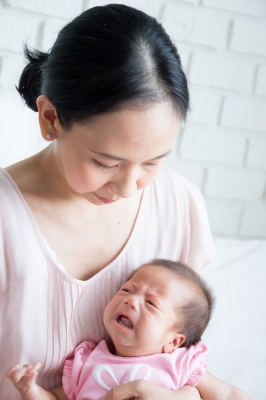 I’m renaming my recurring links posts “intentional links” rather than “Wednesday links” so I can bless you with great links on any ol’ day. 🙂
I’m renaming my recurring links posts “intentional links” rather than “Wednesday links” so I can bless you with great links on any ol’ day. 🙂
In this edition: infant crying and fussing. Here I’m selecting links that help us understand unexplained crying (rather than cry-it-out sleep methods).
The Frenzied Cry: How to Calm Your Baby. A couple of interesting suggestions for reducing colicky crying when the usual stuff doesn’t work: eliminating foremilk in breastfeeding and adding pro-biotics to baby’s diet even when breastfed.
Infant Crying, Fussing, and Colic: A Thinking Parents Guide from Gwen Dewar has a great deal of insight about why babies cry and what you can do to calm them. She says babies are soothed by feeding (Shaw et al 2007), skin-to-skin contact (Gray et al 2000), and gentle touches that are combined with other forms of communication, like talk or eye contact (White-Traut et al 2009). Fascinating: in a study of 3 groups that included London parents, Copenhagen parents, and a group that practiced “proximal care” — holding baby 80 percent of the time, responding quickly to baby’s cries, and feeding frequently, “the London parents had the least amount of physical contact with their babies—50% less compared with the parents practicing proximal care. These parents also had the babies who cried the most.”
Simple Ways to Calm a Crying Baby by Darcia Narvaez. This piece focuses on babies who fuss and cry a lot at night. Dr. Narvaez’s key points: 1) A parent’s presence helps to calm babies who awaken in an upset state, 2) Calming infants helps infants learn to calm themselves. She offers a list of methods for calming baby back to sleep including recreating the womb, relying on familiar sounds, and skin-to-skin contact.
Why Infant Carrying Soothes a Baby When Nothing Else Will from Dr. Greg. Do you have a baby who fusses unless you are carrying him? “It turns out that carrying an infant triggers a three-way mechanism in the brain that suppresses involuntary muscle movements & struggling while also dramatically reducing the infant’s heart rate. These changes happen almost immediately. In fact, this process is such an automatic response to being carried that it could almost be considered a previously undiscovered reflex.”
Image credit: Phaen Din (freedigitalphotos.com)
